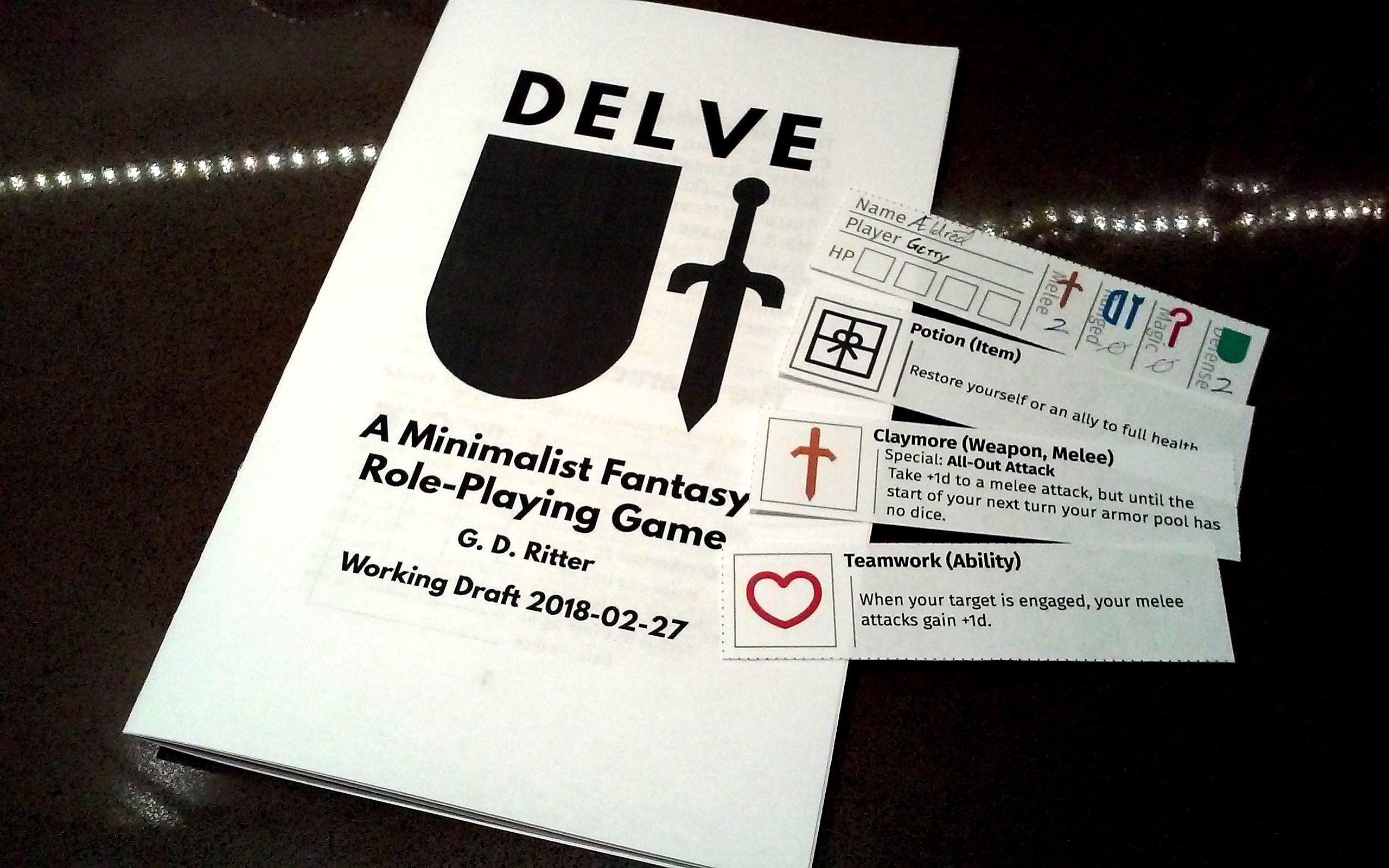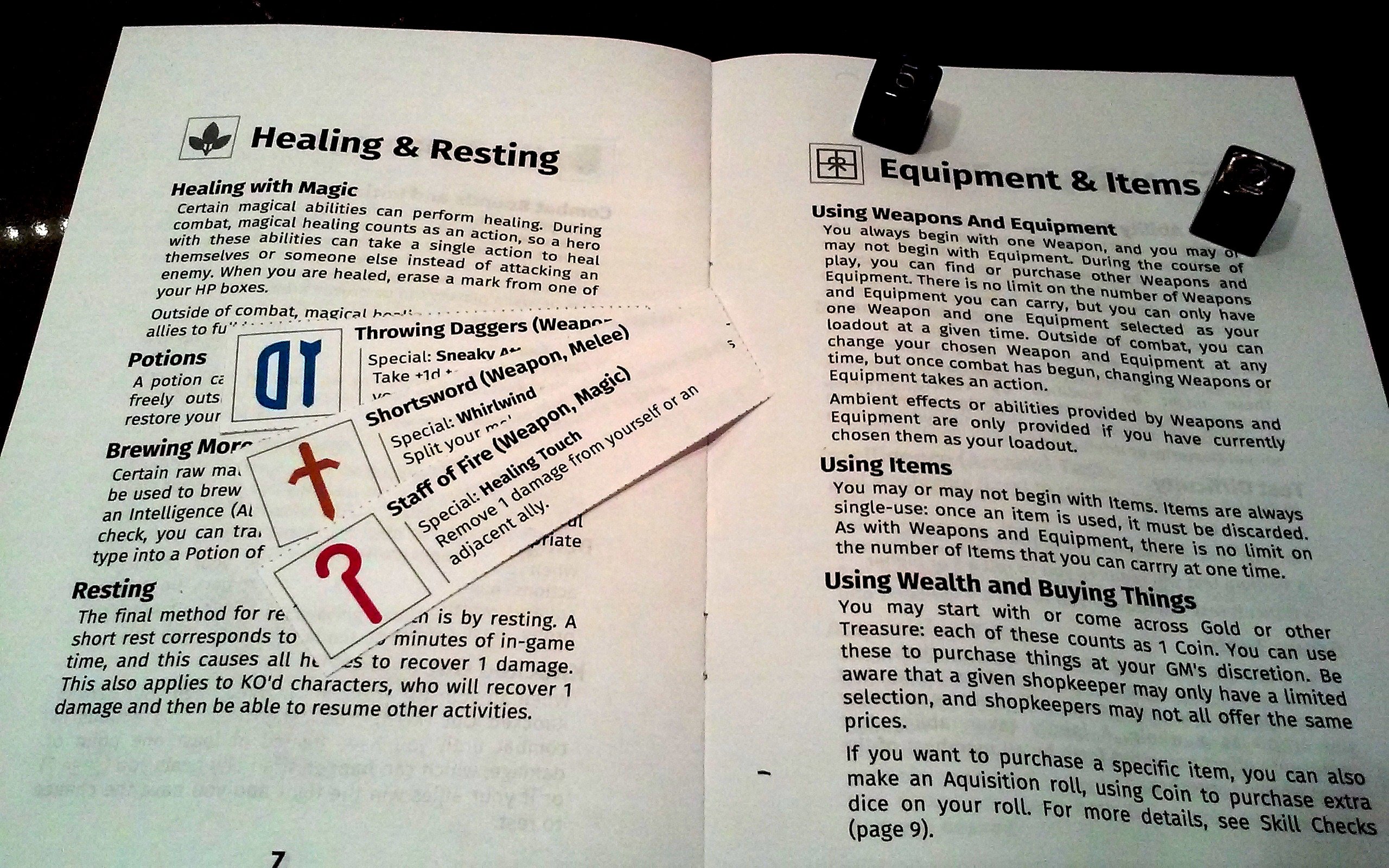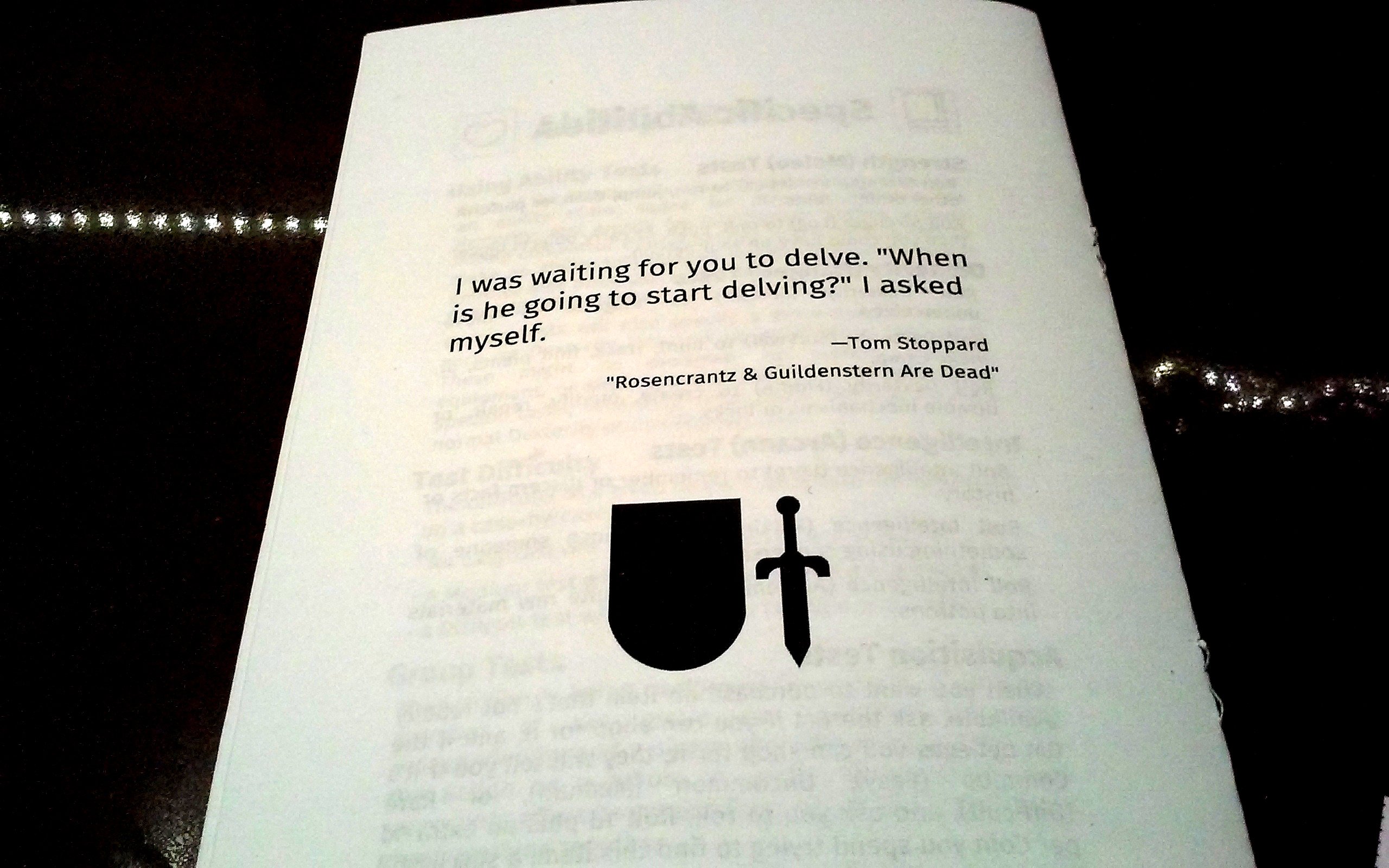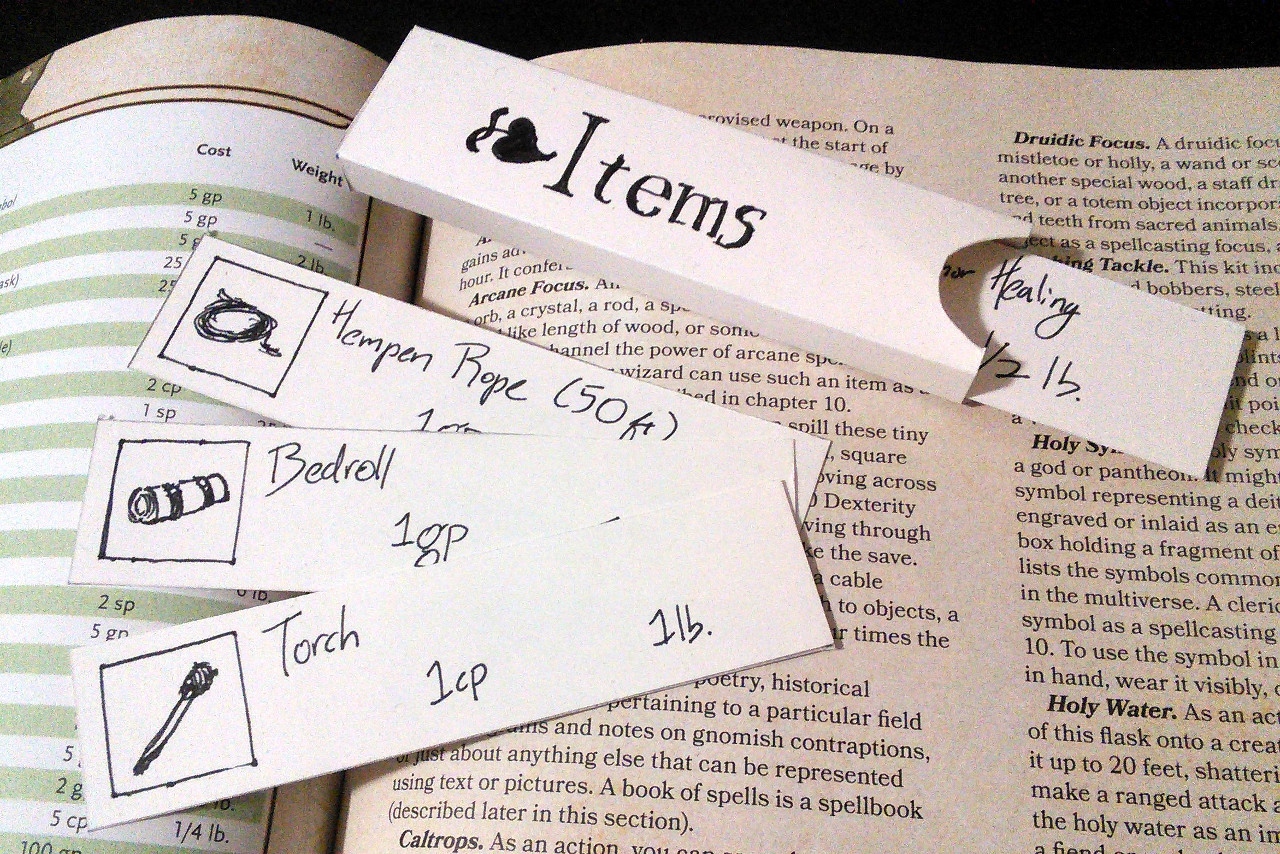Social mechanics in TTRPGs
I'm a strong proponent of designing tabletop games with mechanical rules for social interaction. This is something which is relatively loosely-defined in many existing tabletop games, so I think it's worth digging into what this can mean and why I think it's worthwhile, and in the process address a few of the common issues that people run into with social mechanics. In particular, I want to make it clear that social mechanics can have advantages, but not all social mechanics are good. This blog post is going to describe three properties that good social mechanics can bring to tabletop games, and contrast them to social mechanics that don't necessarily pull their weight.
What do we mean by “social mechanics”?
I think a reasonable definition of 'social mechanics' is, “Any kind of well-defined mechanical rule that dictates some aspect of social interaction.” To give an example of what a social rule looks like, I'm going to turn to Apocalypse World: Burned Over, which features this move:
When you charm or deceive someone, roll+Cool. On a 10+, they have to choose: set skepticism aside and go along with you, or else call you a fool or a liar to your face. On a 7–9, if they don't want to go along with you or call you out, they can choose to ask you for evidence, time, a compromise, or some concrete assurance; they must go along with you if you provide it. On a miss, be prepared for the worst.
Or an even more clear-cut example from Blades in the Dark, where one ability given to the Slide playbook is:
Like Looking into a Mirror: You can always tell when someone is lying to you.
Both of the above are mechanical rules that dictate aspects of social interaction. Beyond that, they're well-defined. If I'm playing Apocalypse World and I try to charm or deceive someone, then I may not know which outcome I'm going to get—I'm rolling dice, after all—but I know for sure what outcomes can result from that move. If I'm playing Blades and I have the ability described above, then I know for certain that no character can lie to me. (Or, at the very least, if someone does and I'm not aware of it, then we're not playing the game according to the rules!)
I also talk about “some aspect of social interaction” rather loosely because I want to make it clear that social mechanics can encompass a wide variety of goals and levels of abstraction. Both of the above moves deal with specific outcomes from either a single exchange or conversation, but social mechanics don't need to be related just to talking: a good example here is the Blades in the Dark system of Status, which uses numerical values to represent how friendly or unfriendly various other factions are towards your own faction. Yet again, these mechanics are social in that they provide mechanical basis for interactions with NPCs, and they are well-defined in the sense that, if I perform actions which lower my status with another faction to -3, that faction will go to war with my own faction, and that will have specific consequences for what we're allowed to do.
Finally, to motivate my requirement that social mechanics be well-defined, here's what the D&D 5E Dungeon Master's Guide says about “Social Interaction”:
During a social interaction, the adventurers usually have a goal. They want to extract information, secure aid, win someone's trust, escape punishment, avoid combat, negotiate a treaty, or achieve whatever other objective led to the interaction in the first place. The creatures they interact with also have agendas.
Some DMs prefer to run a social interaction as a free-form roleplaying exercise, where dice rarely come into play. Other DMs prefer to resolve the outcome of an interaction by having characters make Charisma checks. Either approach works, and most games fall somewhere in between, balancing player skill (roleplaying and persuading) with character skill (reflected by ability checks).
The phrasing here is why I specify that social mechanics should be well-defined, because D&D 5E's rules for social interaction are very much not well-defined. There are rules I can use which affect social interaction—for example, using skills like Deception or Intimidation—but not only is there no fixed outcome for what a “successful Deception roll” looks like, there's no guarantee that the GM would even want you to roll it in the first place, since a given GM might decide that either in general or in this specific circumstance they want you to roleplay the intimidation instead.
A very significant consequence here is that a player can't rely on social mechanics being present or effective, at least not without knowing a specific GM's preferences around how the game runs. If I start playing a fresh D&D character with a new GM, would it be worth putting some points into Charisma? Well, if the GM will call for or allow Charisma checks, then maybe, but if the GM prefers roleplaying these conversations out without letting dice influence the outcomes, then my Charisma is significantly less useful. The lack of definition in the game rules means that trying to engage with those mechanics is risky for players—if there's a chance that my hard-earned XP is going to go a mechanic that might not do a thing, why even spend it?
What do you get out of social mechanics?
One of the most common objections to social mechanics—especially in the context of D&D and closely related games—is that they're simply redundant when compared with role-playing. Imagine, for example, that a rampaging dragon is moving towards a town, and the players demand an audience with the local ruler to request the evacuation of the town. Why roll, when you can ask the players to make their demands as their characters would? If the players are convincing, the guard is convinced: why do you need anything more?
There's a common way that arguments about this usually happen: the person who likes social mechanics will say, “We don't usually ask players to pick up a sword to see if they succeed in combat, so why do we ask players to actually debate to see if they succeed in a debate? How do we account for players whose characters are mechanically charismatic but don't feel they can rely on that same level of charisma in real life?” while the person who dislikes social mechanics will respond, “We're already speaking in real life, so why abstract it out with mechanics? If you're not comfortable fully roleplaying the conversation, then you can describe what you'd want to say instead of saying it word-for-word. And anyway, if the players are convincing during role-play, it's not fair to them to deny them that success just because the dice rolled poorly.”
I think there are some very good reasons to include social mechanics that aren't addressed by the arguments above. One of the first ones, for me, is social mechanics can produce interesting unplanned outcomes, which is something I personally find deeply valuable in tabletop games.
Consider applying the rule from Apocalypse World: Burned Over that I described above to the scenario with the guard blocking access to the town's ruler. The players can roll and succeed, in which case the guard can either agree to let them see the ruler, or explicitly and loudly call them out as liars. Or, the players can roll and partially succeed, in which case the guard might ask for evidence—some proof that a beast is indeed approaching—or a compromise—such as allowing them access to a lower-level functionary rather than the ruler, or demanding some manner of bribe.
When I described the scenario to begin with, I may have had two broad potential outcomes in mind: either the guard agrees and allows the party to see the ruler, or the guard rejects the party is kept outside. I may not have had other outcomes in mind, but having mechanics around social interactions can produce those outcomes. These outcomes can move games into very different directions, which can be a lot of fun and produce amazing stories afterwards.
Another reason I find social mechanics valuable is that social mechanics provide player affordances. Here I'm using the word “affordance” specifically in the way it's deployed by designer Donald Norman, who uses it to refer to the possibilities of action that are suggested by an object: objects with handles might suggest being held, objects with feet might suggest being placed, objects with upward-facing padded surfaces might suggest being sat on. Interface designers and human-computer interaction researchers are interested in affordances because they can help make objects usable without specific training: an object with the right affordances (and the right cultural context for those affordances) can by its very design suggest how to use it.
It's worthwhile to think of tabletop games as providing affordances, which are the actions it suggests are available to players. In theory, a player could come up with any course of action—indeed, this freedom is something that makes tabletop games special relative to, say, board games or video games—but in practice there are specific actions which the game suggests strongly by virtue of how it provides mechanical support for them.
For example: I can flip through the D&D rulebook and see extensive rules about how to engage in various kinds of combat, and indeed, most of a player's abilities are combat-related. On the other hand, there's no reason I couldn't have a D&D character who is strongly invested, say, in state-building and creating governments, but there's nothing in D&D's rules that imply that this is a course of action that you're likely to take. Looking at my player sheet, it's clear the game has affordances, actions which it suggests—there's even a list of skills right there!—and by and large players will embrace the affordances of the game most of the time.
I think that many tabletop players share the common experience of coming across a problem and starting to look through their character sheet to see if they've got a specific way of addressing that problem: a relevant piece of equipiment, a proficiency or ability that addresses it, anything which can give a bit of an edge. It's not uncommon to jog your mind in doing so. I might not have considered trying to blast my way through the door instead of picking the lock, but I perused my character sheet and found that I still had dynamite: why not?
So if you check your character sheet and you see skills related to interacting with people—bonuses to specific interactions, conversational stratagems, specific NPC contacts—then social actions become part of the set of affordances provided by the game. A good example I've experienced many times is having a list of contacts in Blades in the Dark: a player is confronted with a problem, checks their sheet, and notices an NPC whose role might give them special insight into the problem at hand. This little affordance helps push that player into a social situation when they might otherwise have picked up a weapon.
It's also worth noting that, in many games, becoming better at combat is a big enticement to, well, doing more combat. In games where advancement can provide bonuses or the ability to exercise social mechanics, this becomes an enticement to engage in social activites more. Yet again, Blades in the Dark provides some good examples, as many playbooks have specific social moves which they can take as upgrades, and that in turn makes certain kinds of social interactions more appealing as players have advantages in those interactions.
Yet another reason is that some social mechanics can situate players into the world more explicitly. Not every kind of social mechanic does this, but an appropriately-designed one can.
One way this might happen is by providing social mechanics around information-gathering. Consider another move from Apocalypse World: Burned Over:
When you read someone in a charged interaction, roll+Sharp. On a 10+, hold 3 against them. On a 7–9, hold 2 against them. During your interaction, spend your hold 1 for 1 to ask the MC or their player questions. They have to answer frankly, from their character's point of view. – Are you telling the truth? – What are you feeling? – What are you thinking of doing? – What do you hope I'll do? – How could I get you to do [x]? On a miss, the MC might have you ask 1 anyway, but be prepared for the worst.
This move is designed to give players access to social information and cues which might be hard to convey through just dialogue. After all, even with the most descriptive prose possible, we're still dealing with an entire world conveyed through a stream of dialogue from one person, and that's significantly less information than we'd get if we could somehow immerse ourselves in a full simulation of that world: a mechanic like this helps players get reliable access to specific social information that might otherwise get lost.
For example, if we apply the above move to the scenario with the guard, we might imagine a player trying to read this person to figure out: what's important to them? Can we deduce anything about the guard's emotional state? What other cues can we read from the guard?
Another way that social mechanics can situate players in the world is by subjecting their players to mechanized versions of social pressures. Consider, for example, augmenting D&D 5E with a factional reputation system: perhaps players who help out specific factions might get extra points which can translate to bonuses on social rolls, but interfering with factions or causing trouble for their members can translate to negative modifiers on those rolls.
How might this affect our guard? Well, if the players are well-respected in that community, the faction modifier means the guard is mechanically more inclined to trust the party: they've helped out the town, after all. On the contrary, if the players had previously caused trouble in the town, now the guard is mechanically less-inclined to help them.
(It's worth noting that this is interesting even if the modifiers don't cause the rolls to swing in the expected direction: if the players have a high reputation but still fail the roll, then it's interesting story-wise that the guard won't let the party see the ruler despite their high status: why might that be? Or if the players have a low reputation but still succeed: why did the guard agree to let this known band of brigands in to the ruler in this case?)
There are other kinds of social mechanics which help here: for example, mechanized relationships or contacts with NPCs help cement PCs as inhabitants in a world, or mechanization of various kinds of group status can help situate players in a world by opening or closing avenues of action to them.
What makes a good social mechanic?
I think one of the biggest objections to social mechanics in practice isn't actually a mark against the idea of social mechanics in general: rather, it's because many people have had exposure to bad or pooly-thought-out social mechanics.
Consider, for example, the not uncommon story of a player who has managed to maximize their character's abilities around social interaction, resulting in a character who can steamroll any conversation and make any NPC agree with them. At some point, this level of forced interaction with NPCs feels less like a reflection of a character with high charisma and more like some kind of mind control or other coercion, and it can remove stakes or drama from the story being told.
This isn't because the idea of a social mechanic is flawed: it's because this social mechanic has a flawed implementation! There's an implicit understanding of how a social mechanic in something like D&D might work. This isn't present in any source book (and consequently the problems with this rule shouldn't be considered a knock against D&D here) but people might imagine D&D's social rolls as working like this:
When you use deception, trickery, or lies to get an NPC to believe or do something specific, make a Charisma (Deception) check against a DM-specified target number. If this succeeds, the NPC will believe you or do what you want. If it fails, then the NPC will not believe you and will not do what you want.
This is actually in some ways more well-defined than the actual D&D 5E rule for deception, which does not specify any specific outcomes for success or failure, only the situation in which it can be used. Unfortunately, though it's a very flawed implementation of that mechanic: once a character has high enough Charisma and if the GM has this understanding of social mechanics, it's difficult not to get NPCs to do what you want all the time.
Contrast the above example with the Apocalypse World: Burned Over example from above. Here's the success case from that roll:
On a 10+, they have to choose: set skepticism aside and go along with you, or else call you a fool or a liar to your face.
There are two things I'd call out here. One of them is that a success on this roll doesn't mean the NPC believes you: they might still reject what you're telling them, but they'll reject it loudly and bring that conversation to a head. That means even with tons of modifiers and a high number in the relevant stat, there's no guarantee that a player using this move will be able to bring every NPC they come across to their side, but it does allow them to move the interaction along by at the very least getting the disagreement to come out in the open.
There's another important detail I'd call out about this rule, as well: even if the NPC doesn't call you out directly, they still don't necessarily believe you, since the rule specifies that they will “…set skepticism aside and go along with you.” This means that, even if the NPC is doing what you want, they might only be doing so provisionally: you haven't convinced them that you're right, you've just given them enough reason that they're just willing to go along with you.
These differences aren't trivial: they're very important both to balancing the mechanic in question and to making sure it doesn't take over the narrative. Making sure that outcomes are well-defined but not unilateral is a key part of making social mechanics which people can rely on but which don't end up amounting to players dominating all social exchanges.
This isn't unique to social mechanics, after all: all parts of a game need playtesting and balancing and so forth. A combat mechanic which allows a player to one-shot every enemy would likely be considered incredibly overpowered and in need of balancing: a social mechanic which allows a player to get what they want out of every conversation should be treated the same way. (If you want to get a good look at what this process might look like, I'd recommend this blog post by Jeremy Strandberg which talks extensively about the revisions to Parley, the primary social move in Dungeon World, and how he revised it for his derived games Homebrew World and Stonetop. It's a long process, and very subtle parts of the wording can have a big effect on how that social move plays!)
Finally, I think it's worth noting that mechanizing social mechanics doesn't mean that all social interaction should turn into a mechanical back-and-forth. I think there's a fear that social mechanics, taken too far, could result in all conversations becoming a sequence of players invoking the mechanics—”I use witty jab! I use clever repartée! I use sardonic gesture!“—instead of actually getting into character and having dialogue. I don't think this is necessarily an unfounded fear, but I don't think it's the end-goal of adding social mechanics to a game. In fact, it runs contrary to one of the advantages of well-designed social mechanics that I describe above: this doesn't help situate players in the social realities of the world, it divorces them from it!
I think the advantages I've described to social mechanics can be used in an inverse way, to evaluate whether a social mechanic is pulling its weight. You can look at a mechanic and ask, “Is this helping me get to outcomes that we might not have come to?” If not, maybe it's not adding much value that wouldn't get from just role-playing those conversations. “Is it giving players social affordances that let them tackle problems via social means?” If not, maybe it's not pulling its weight in complexity, or maybe it's either too broad or too narrow and needs adjusting. “Is it helping situate player characters in the world socially in a way that players understand and react to?” If not, maybe think about how the mechanic might be relaxed, reworked, or refocused to help underscore and mechanically reinforce the social structures of the game world.
And of course, I think it's worth noting that none of these should replace role-playing. Let's go back once more to the example with the guard: if I were running this in a game with social mechanics, I wouldn't simply ask the players to roll: I'd first roleplay out the scene, and ask the players to roleplay out their attempt to convince the guard, and then bring the mechanics down in order to figure out how the scene ends. The social mechanics should inform the narrative, not replace it.
So hopefully this provides a case for why I believe social mechanics are worthwhile to implement, and give some advice in terms of how to implement them in a way that plays towards their strengths!



